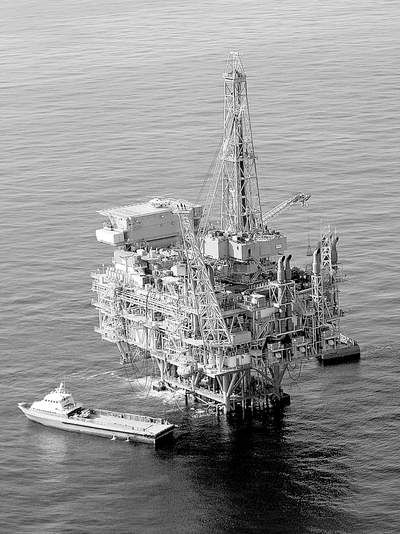Has offshore drilling gotten cleaner?
Published 5:00 am Sunday, August 3, 2008

- An offshore oil rig in the Gulf of Mexico in 2005. Coastal drilling technology “has improved — the safety systems we now require have greatly improved — and the (industry) has a good record,” said Randall Luthi, director of the Interior Department’s Minerals Management Service, which handles offshore oil field regulations. Improvements include tougher building materials on platforms.
SANTA BARBARA, Calif. — What sticks in Charlie Eckberg’s mind about that horrible January of 1969 was how the mighty Pacific went silent.
Oil from a blowout under a drilling platform six miles offshore made the water so thick and heavy that the crashing surf Eckberg was used to hearing at his beachfront home was eerily quieted, like a fallen giant.
“And then you started to see the animals,” he recalled.
First were birds, too many of them to count, said Eckberg, who’s now 60 and still lives here. Then came the oil-coated seals and otters and other sea life. “It changed my life,” he said of the sight. Today, Eckberg can’t look at the oil platforms still dotting the sea off Santa Barbara without disdain. He’s now an environmental activist, an eco-friendly real estate developer and director of a group called Get Oil Out.
Almost 40 years after the blowout at Union Oil Co.’s Platform A resulted in the nation’s most environmentally damaging drilling accident, government and industry officials say new offshore technologies and techniques make it almost impossible for a similar disaster to occur again.
That’s a point President Bush has made repeatedly in recently lifting an executive order banning new offshore oil exploration. He is asking Congress to lift its separate ban.
Last week, the Interior Department took steps to jump-start new offshore oil exploration, announcing plans for a lease program that could open up new areas off the coasts of Florida, Georgia, Texas, North Carolina and other states to drilling if Congress lifts the ban. On Friday, the department began taking public and industry comment on the plan.
“The technology has improved — the safety systems we now require have greatly improved — and the (industry) has a good record,” said Randall Luthi, director of the department’s Minerals Management Service, which handles offshore oil field regulations and leases.
What has improved?
New tools that make offshore drilling safer include high-tech computers that make exploration easier to tougher building materials on platforms, according to Luthi and others. They include:
•Seismic technology and directional drilling techniques that let oil companies drill 100 exploratory wells from a single offshore platform. That reduces the number of derricks and therefore the potential for problems, they say.
•Automatic shutoff valves underneath the seabed can that cut the flow of oil immediately if there’s a problem or a storm coming. Blowout prevention equipment can automatically seal off pipes leading to the surface in the case of an unexpected pressure buildup.
•Undersea pipelines and wellheads that can be monitored with special equipment such as unmanned, camera-equipped underwater vehicles and sensor-equipped devices called “smart pigs.”
•Advances in metallurgy and construction techniques that have made platforms stronger and more likely to withstand hurricanes and other calamities.
“Any human endeavor has some level of risk,” said Dave Mica, director of the Florida Petroleum Council, which is pushing for drilling off the Sunshine State. “We can’t eliminate all of it. But we’re trying.”
Interior Secretary Dirk Kempthorne said hurricanes Katrina and Rita provided the ultimate test of modern-day drilling operations. About 3,000 of the 4,000 oil platforms currently in the Gulf of Mexico were in the direct path of the two hurricanes in 2005, he said, yet there were no major spills.
“The shutoff valves below the ocean floor, all of them worked,” Kempthorne said. “There was no significant loss of oil.”
Still, spills occur. Last year alone, according to the Minerals Management Service, about 2,225 barrels of oil were spilled in coastal waters because of mishaps involving offshore rigs. Even though the Interior Department and others don’t deem them major spills, more than 16,280 barrels of oil were spilled in 2005, the year hurricanes Katrina and Rita hit.
Just last week near New Orleans, a spill occurred in the Mississippi River after a tanker ship hit a barge carrying 419,000 gallons of oil.
Given that many existing oil platforms and other equipment are decades old, it’s a little surprising there haven’t been more spills, said Bruce Bullock, director of the Maguire Energy Institute at Southern Methodist University in Dallas.
Bullock, who worked for an offshore oil services company for 25 years before joining academia, also cautioned that offshore drilling and well-management operations are only part of the equation. The nation’s worst oil spill involved a tanker — the Exxon Valdez — not an offshore platform.
“Let’s say you’re talking about offshore Florida,” Bullock said. “In reality, there’s probably more risk of an incident from a tanker going down the coast to get into the Gulf or vice versa than there is putting a well in 1,000 feet of water.”
And improvements in technology or not, offshore drilling is still plenty risky, opponents say.
“Even if they aren’t spewing out of their rigs, the entire process is incredibly dirty,” said Jennette Gayer, policy advocate for the group Environment Georgia. “There’s no way you can tell me it won’t have an impact on our coast, and our coast in Georgia is incredibly valuable.”






